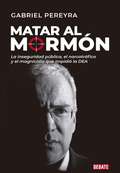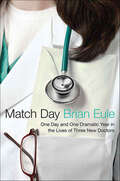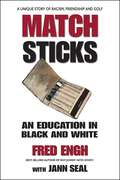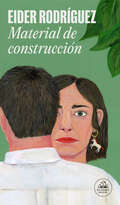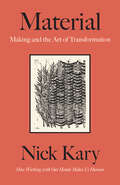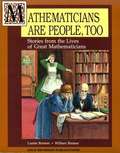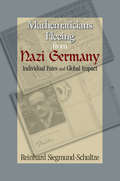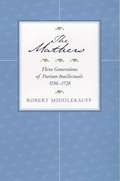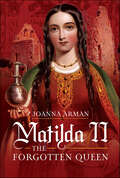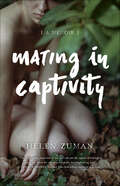- Table View
- List View
Mastery, Tyranny, and Desire
by Trevor BurnardEighteenth-century Jamaica, Britain's largest and most valuable slave-owning colony, relied on a brutal system of slave management to maintain its tenuous social order. Trevor Burnard provides unparalleled insight into Jamaica's vibrant but harsh African and European cultures with a comprehensive examination of the extraordinary diary of plantation owner Thomas Thistlewood.Thistlewood's diary, kept over the course of forty years, describes in graphic detail how white rule over slaves was predicated on the infliction of terror on the bodies and minds of slaves. Thistlewood treated his slaves cruelly even while he relied on them for his livelihood. Along with careful notes on sugar production, Thistlewood maintained detailed records of a sexual life that fully expressed the society's rampant sexual exploitation of slaves. In Burnard's hands, Thistlewood's diary reveals a great deal not only about the man and his slaves but also about the structure and enforcement of power, changing understandings of human rights and freedom, and connections among social class, race, and gender, as well as sex and sexuality, in the plantation system.
Mata Amritanandamayi: Life and Experiences of Devotees
by Swami Amritasvarupananda PuriThis book vividly portrays the Holy Mother's courage and intense devotion to God in the face of attacks by unsympathetic relatives and hostile detractors who feared the changes brought about by Her universal love. From Her childhood itself, Amma was endowed with an ineffable love for God, and She immersed Herself in that quest, even without a Guru. Treated as a servant by Her family, Amma continued in that role until Her conscious absorption in the bliss of God-Realization made it impossible for Her to discharge Her endless chores. She spent Her time in meditation, devotional singing and dancing, totally absorbed in God Consciousness. In due course, sincere seekers of Self-Realization sought Her out in Her remote village in Southern India and found guidance and gained the strength to walk in the spiritual path. Millions have received contorting reassurance and love.
Mata Hari's Last Dance: A Novel
by Michelle MoranFrom the international bestselling author of Rebel Queen and Nefertiti comes a captivating novel about the infamous Mata Hari, exotic dancer, adored courtesan, and, possibly, relentless spy.Paris, 1917. The notorious dancer Mata Hari sits in a cold cell awaiting freedom…or death. Alone and despondent, Mata Hari is as confused as the rest of the world about the charges she’s been arrested on: treason leading to the deaths of thousands of French soldiers. As Mata Hari waits for her fate to be decided, she relays the story of her life to a reporter who is allowed to visit her in prison. Beginning with her carefree childhood, Mata Hari recounts her father’s cruel abandonment of her family as well her calamitous marriage to a military officer. Taken to the island of Java, Mata Hari refuses to be ruled by her abusive husband and instead learns to dance, paving the way to her stardom as Europe’s most infamous dancer. From Indian temples and Parisian theatres to German barracks in war-torn Europe, international bestselling author Michelle Moran who “expertly balances fact and fiction” (Associated Press) brings to vibrant life the famed world of Mata Hari: dancer, courtesan, and possibly, spy.
Matar al mormón: La inseguridad pública, el narcotráfico y el magnicidio que impidió la DEA
by Gabriel PereyraUn jefe policial en medio de la guerra entre dos narcos. Sicarios extranjeros buscando explosivos militares en Montevideo. Un topo de la DEA que atina a dar una alerta providencial. Gabriel Pereyra rescata un episodio hasta el momento desconocido del periplo profesional del implacable policía antidrogas Julio Guarteche, dejando en evidencia la perversión de límites que maneja el narcotráfico. A través de sus columnas que durante 25 años aparecieron en El Observador y en Búsqueda, el periodista ilumina los vericuetos del siempre sensible debate sobre la seguridad pública, fijando posición, en muchas ocasiones, contra la corriente mayoritaria que piensa que este complejo asunto se soluciona con un cambio de autoridades. En estos textos, la seguridad adquiere perfiles tanto de crónica policial como de denuncia social. Y el discurso de que la pobreza y la delincuencia no tienen un vínculo entre sí se da de bruces con un dato indiscutible: casi la totalidad de los presos son pobres o provienen de hogares marginales.
Matar el nervio
by Anna PazosMatar el nervio es una descarnada revisión de una juventud que está llegando a su final. «La turbulencia de en medio es difícil de explicar. Queremos pensar que las decisiones irracionales las toman los demás y que nosotros actuamos con entereza, lucidez y amor propio. Después nos encontramos en medio del ciclón y el mundo se pone del revés. Lo quedesde fuera parece una profanación imperdonable tiene ahora una explicación plausible. La decisión recta y evidente ahora resulta cobarde y la que habríamos dicho que implicaba negación y abyección denota generosidad y grandeza de espíritu». Matar el nervio es la descarnada revisión de una juventud que busca su final. Es el lugar de expiación de una década vital, la de losveinte, ansiosa por obtener respuestas. Son fragmentos de una autobiografía sin secretos donde la literatura se funde con la vida. Un nervio indómito, huidizo, caprichoso, conducirá a la autora a Grecia, Israel, Turquía y Estados Unidos para finalmente sumergirse en la historia de su propia familia. Su atracción por los personajes extremos hará el resto.La mirada de Anna Pazos es desafiante e incisiva: periodística. Liberada y talentosa, osada y fiestera, Pazos abre interrogantes que deja flotando en una atmosfera formada por la potencia portentosa de su escritura. Quién sabe si, sin pretenderlo, ha escrito un retrato generacional de primer orden.
Mataron a Flores: Intriga y poder en los albores del Uruguay moderno
by Fernando KleinUna novela narrada con rigurosidad histórica y ritmo de thriller sobre uno de los episodios más enigmáticos y violentos que vivió el Uruguay. El 19 de febrero del año 1868, las vidas del general Flores y del ex-presidente Prudencio Berro se jugaron en un escenario minúsculo de Montevideo: entre las calles Mercedes y Uruguay y el llamado Fuerte o la antigua casa de gobierno, en la actual plaza Zabala. Berro inició una aventura revolucionaria con un plan que preveía el ataque simultáneo a seis objetivos: el Fuerte, el Cuartel de Dragones, la fortaleza de San José y las comisarías de Manga y la Unión, pero la revuelta rápidamente se hundió en el fracaso, rechazados todos los intentos revolucionarios. Flores buscó acudir al centro de los acontecimientos, pero su carruaje fue prontamente interceptado por «emponchados con sombreros», quienes con armas de fuego y luego puñales terminarían con su vida. Su imagen agonizando sería inmortalizada en una pintura por Juan Manuel Blanes. Don Berro fue detenido y llevado a la jefatura de policía, el actual Cabildo, negando haber intervenido en la muerte del general: fue asesinado en las mazmorras del edificio. «¡Mataron a Venancio Flores!», fue el rumor y luego el grito ensordecedor que se extendió por toda la ciudad de Montevideo. Esa jornada pasaría a la historia como «el día de los cuchillos largos»: desde ese entonces la autoría de los asesinatos de Flores y Berro sigue siendo una incógnita que este libro procura develar.
Match Day: One Day and One Dramatic Year in the Lives of Three New Doctors
by Brian EuleThree new doctors—all women—struggle to balance professional ambitions and personal relationships, triumphs and crises, uncertainties and decisions, through one pressure-packed day and the first year of their careers in medicine Each year, on the third Thursday in March, more than 15,000 graduating medical students exult, despair, and endure Match Day: the decision of a controversial computer algorithm, which matches students with hospital residencies in every field of medicine. The match determines where each graduate will be assigned the crucial first job as an intern, and shapes the rest of his—or, in increasing number, her—life. In Match Day, Brian Eule follows three women from the anxious months before the match through the completion of their first year of internship. Each woman makes mistakes, saves lives, and witnesses death; each must keep or jettison the man in her life; each comes to learn what it means to heal, to comfort, to lose, and to grieve, while maintaining a professional demeanor. Just as One L became the essential book about the education of young attorneys, so Match Day will be for every medical student, doctor, and reader interested in medicine: a guide to what to expect, and a dramatic recollection of a pressured, perilous, challenging, and rewarding time of life.
Matchbook: The Diary of a Modern-Day Matchmaker
by Samantha DanielsFans of Sex and the City and Bridget Jones's Diary, and anyone who loves to date vicariously, will fall in love with Matchbook. In this irresistible read, America's hippest Matchmaker borrows from her real-life experiences to create an urban love story about searching for "The One." When people learn what Samantha Daniels does for a living, they have to know more: How did she become a Match-maker? How many matches have led to marriage? How does it work? Who's her craziest client? And most of all, how can a Matchmaker be single? Samantha Daniels is unlike any Matchmaker you've ever heard of. Young, ambitious, and, yes, single, she's the founder of Samantha's Table, an introduction service that caters to singles in New York and Los Angeles who are ready to invest seriously in the task of finding The One. After handpicking their matches, Daniels works with her clients as their cheerleader, part-time therapist, dating coach, voice of reason, and closest confidante as she helps them down the road to happily ever after. Readers learn how Daniels started her Matchmaking business (How much do you charge for finding the love of someone's life? How do you screen out the Undatables?) and get to know the colorful cast of characters whom she fondly refers to as her "Desperados." There's Mr. Cheapskate, Miss Manhunt, and Looks Good from Afar Guy. There's the 39-year-old female corporate exec who wants a husband yesterday; there's the guy who will only date women worthy of Brad Pitt; there's the gazillionaire who offers a $60,000 bonus if Samantha can find him a supermodel wife; there's the very well endowed woman who's having trouble finding men attracted to her mind; and a host of others. Will Samantha be able to make them a match? And more importantly, will this Matchmaker find herself a match? You would think that meeting hundreds of single men would make dating a snap, but not even a Matchmaker can avoid the pitfalls of single life. Readers are introduced to another lively cast of characters -- the men that Daniels herself dates. Readers meet the many Not for Me Guys and a few Maybe for Me Guys, to see that even a celebrated Matchmaker can be a Desperado herself. Throughout the book, Daniels also offers real dating advice (such as the most common first-date mistakes and tried-and-true conversation topics) and secrets of the trade (why September is the best month for Matchmaking). Like a real-life episode of The Bachelor, Matchbook is a wild ride through the flirty, unpredictable world of urban dating, with a wise and witty guide at the helm. For those who love romance and anyone looking for love, Matchbook is a perfect match.
Matchsticks: An Education in Black and White
by Fred Engh Jann SealThe year was 1961, a year marking the start of the racial unrest that would last throughout the decade. Living in a trailer camp in Maryland with his wife and children, Fred&’s future seemed bleak—that is, until he heard a college football coach being interviewed on a local radio show talking about becoming a Physical Education teacher. The coach&’s words would inspire him enough to register at Maryland State College, a then all-black college. The thing of it was, Fred Engh was white. He would become the first white student to attend Maryland State, a segregated college. His intention was not to break any racial barriers or make any headlines. He simply wanted a better life for himself and his family as an accredited teacher. What he learned from attending that college however was something he had not expected. Matchsticks: An Education in Black & White is his story.Fred Engh and his non-profit organization, NAYS—the National Alliance for Youth Sports—have positively affected the lives of millions of children throughout the country for decades, but chances are you have never heard of him or his group. What he has tried to do is make organized sports for kids fun. He has done this by training coaches to be fair, avoid playing favorites, bulling players, and stopping fans from getting out of control. He has also tried to even the playing field for children of different colors and ethnicities. From baseball to soccer to golf, he has made it his mission to let children choose to play the sport they love—no matter where they live or how well they play. And yet, the story behind how he discovered his calling in life is definitely a remarkable one of transition.Today, when racial disparagement has once again taken the form of marches, protesters, and daily news headlines, here is a tale of discovery, understanding, and personal change. A lesson still as valuable today as it was then.
Material Witness
by Ted LeighAmerican painter Fairfield Porter (1907-1975) was an iconoclast who developed a singular style that was outside the politically correct boundaries of both left and right. This collection of letters sheds light on Porter's personal views and displays his acumen as a political critic. It encompasses letters from his early travels to the Soviet Union (including a description of an interview with Trotsky) as well as later correspondence with close friends. The volume features an introduction by poet/critic David Lehman and notes by Justin Spring, author of . Editor Leigh is an artist, writer, and teacher. Annotation ©2005 Book News, Inc. , Portland, OR (booknews. com)
Material de construcción
by Eider Rodríguez«Una poética implacable contra el dolor, una mirada al mundo que redefine el pasado, un modo de entender la literatura fuera de la norma».Pol GuaschEn esta novela hay veranos, cigarrillos, piscinas, hospitales, caballos, azulejos, cemento, arena, cartas, plantas, fuego, vacaciones, amores, mentiras, verdades, vergüenzas... y también alcohol, que lo impregna todo, estropeándolo y deformándolo. Porque el padre es alcohólico. Y ella, la hija de un alcohólico. Pero ¿qué más hay detrás de ese hombre que vendía materiales de construcción y fabricaba muebles reciclando palés?A pesar de haber vivido en la misma casa durante muchos años, padre e hija apenas tienen trato. No se hablan ni se tocan, pero las miradas, los olores y los sonidos les sirven de vínculo. Y el silencio, eso que no se quiere y no se puede decir, es más un campo de batalla que una fortaleza.En su primera novela, Eider Rodríguez ha recogido los fragmentos de un padre para reconstruir, desde diferentes perspectivas y con un estilo brutal y descarnado, el relato de una familia, de una época y de un lugar, sacando a la luz los cauces subterráneos por los que circulan el amor y la vida dentro de los estrechos márgenes del entorno familiar. La crítica ha dicho:«La prosa de Eider Rodríguez, deslumbrante y afilada, nos ayuda a imaginar, pensar y sentir nuestra propia relación con la violencia no desde la denuncia moral o la ideología, sino desde espacios afectivos de incomodidad e incertidumbre».Edurne Portela«Una prosa inteligente, precisa, sin concesiones».Kirmen Uribe«Una maravilla. Una carta al padre, honesta y dolorosa, a corazón abierto. Una excavación y una construcción escrita con mucha inteligencia y valentía».Sara Mesa«La literaturasirve para desentrañar y comprender, y Material de construcción, escrito desde una honestidad incondicional, responde a ese objetivo desdeelconvencimiento de que algunas cosas solo se pueden entender si se escriben».Natxo Velez, EITB Radio Televisión Pública Vasca«Eider Rodríguez vuelve con una obra que resultará ser una marca de agua nueva e importante tanto en su trayectoria como en la memoria de sus lectores. Se trata de un libro intenso, profundo y al mismo tiempo valiente, de una honestidad salvaje. Literatura con letra mayúscula, urgente y necesaria. Desconcertará, turbará y conmoverá a quien lo lea».Harkaitz Cano«Un hermoso trabajo literario que llevará al lector a esa zona brumosa situada entre la desesperación y el recuerdo. Escritura contenida y calibrada. Un estilo excepcional. Es conmovedor presenciar de qué manera influyó la muerte del padre en la protagonista. Un desnudo psicológico profundo. Quizá algunos lectores definan este libro como la protagonista define a su padre: salado y agrio. Sin lugar a dudas, una obra maestra».111 Akademia«Este libro es un ejercicio de memoria, de duelo, y al mismo tiempo una carta de amor».Amaia Álvarez«Un libro que genera estupor».Mikel Asurmendi
Material: Making and the Art of Transformation
by Nick KaryA master craftsperson explores the ways in which working with our hands reveals the essence of both our humanity and our relationship with the natural, material world In our present age of computer-assisted design, mass production and machine precision, the traditional skills of the maker or craftsperson are hard to find. Yet the desire for well-made and beautiful objects from the hands (and mind) of a skilled artisan is just as present today as it ever has been. Whether the medium they work with is wood, metal, clay or something else, traditional makers are living links to the rich vein of knowledge and skills that defines our common human heritage. More than this, though, many of us harbor a deep and secret yearning to produce something – to build or shape, to imagine and create our own objects that are imbued not only with beauty and functionality, but with a story and, in essence, a spirit drawn from us. Nick Kary understands this yearning. For nearly four decades he has worked on commission to make fine, distinctive furniture and cabinets from wood, most of it sourced near his home, in the counties of South West England. During this time, he has been both a teacher and a student; one who is fascinated with the philosophy and practice of craft work of all kinds. In Material, Kary takes readers along with him to visit some of the places where modern artisans are preserving, and in some cases passing on, the old craft skills. His vivid descriptions and eye for detail make this book a rich and delightful read, and the natural and cultural history he imparts along the way provides an important context for understanding our own past and the roots of our industrial society. Personal, engaging, and filled with memorable people, landscapes and scenes, Material is a rich celebration of what it means to imagine and create, which in the end is the essence of being human, and native to a place. As Kary puts it, “Wood and words, trees and people, material and ethereal – it is here I love increasingly to dwell.”
Material: Making and the Art of Transformation
by Nick Kary"An important book, brimming with insight."—Nicholas Evans, author of The Horse WhispererA master craftsperson explores the ways in which working with our hands reveals the essence of both our humanity and our relationship with the natural, material world.In our present age of computer-assisted design, mass production and machine precision, the traditional skills of the maker or craftsperson are hard to find. Yet the desire for well-made and beautiful objects from the hands (and mind) of a skilled artisan is just as present today as it ever has been. Whether the medium they work with is wood, metal, clay or something else, traditional makers are living links to the rich vein of knowledge and skills that defines our common human heritage. More than this, though, many of us harbor a deep and secret yearning to produce something – to build or shape, to imagine and create our own objects that are imbued not only with beauty and functionality, but with a story and, in essence, a spirit drawn from us.Nick Kary understands this yearning. For nearly four decades he has worked on commission to make fine, distinctive furniture and cabinets from wood, most of it sourced near his home, in the counties of South West England. During this time, he has been both a teacher and a student; one who is fascinated with the philosophy and practice of craft work of all kinds.In Material, Kary takes readers along with him to visit some of the places where modern artisans are preserving, and in some cases passing on, the old craft skills. His vivid descriptions and eye for detail make this book a rich and delightful read, and the natural and cultural history he imparts along the way provides an important context for understanding our own past and the roots of our industrial society.Personal, engaging, and filled with memorable people, landscapes and scenes, Material is a rich celebration of what it means to imagine and create, which in the end is the essence of being human, and native to a place. As Kary puts it, &“Wood and words, trees and people, material and ethereal – it is here I love increasingly to dwell.&”Perfect for fans of The Hidden Life of Trees or Norwegian Wood, Material is a rich, inspiring read for woodworkers, potters, craftspeople, bibliophiles and anyone who enjoys working with their hands.
Maternal Megalomania: Julia Domna and the Imperial Politics of Motherhood
by Julie LangfordHow the maternal image of the empress Julia Domna helped the Roman empire rule.Ancient authors emphasize dramatic moments in the life of Julia Domna, wife of Roman emperor Septimius Severus (193–211). They accuse her of ambition unforgivable in a woman, of instigating civil war to place her sons on the throne, and of resorting to incest to maintain her hold on power. In imperial propaganda, however, Julia Domna was honored with unprecedented titles that celebrated her maternity, whether it was in the role of mother to her two sons (both future emperors) or as the metaphorical mother to the empire. Imperial propaganda even equated her to the great mother goddess, Cybele, endowing her with a public prominence well beyond that of earlier imperial women. Her visage could be found gracing everything from state-commissioned art to privately owned ivory dolls. In Maternal Megalomania, Julie Langford unmasks the maternal titles and honors of Julia Domna as a campaign on the part of the administration to garner support for Severus and his sons. Langford looks to numismatic, literary, and archaeological evidence to reconstruct the propaganda surrounding the empress. She explores how her image was tailored toward different populations, including the military, the Senate, and the people of Rome, and how these populations responded to propaganda about the empress. She employs Julia Domna as a case study to explore the creation of ideology between the emperor and its subjects.
Maternidad
by Sheila HetiCrees que lo has leído todo sobre la maternidad hasta que llega Sheila Heti Uno de los libros más esperados del año (The Millions), Uno de los 10 libros más excitantes del año (The Vulture), por una de las nuevas voces norteamericanas (The New York Times y The New Yorker). ¿Qué gana y qué pierde una mujer al convertirse en madre? ¿Puede una creación artística reemplazar a un hijo? Enfrentada al conflicto de toda mujer que se acerca a los cuarenta sin haber tenido hijos, mientras sus amigas se preguntan cuándo van a ser madres, la narradora de Maternidad se pregunta si realmente quiere serlo. La importancia de la creación en su vida, la relación fría que mantiene con su madre o la resolución tomada por su pareja de no intervenir en una decisión que considera que es ella quien debe tomar son algunos de los factores que Sheila Heti pone encima del tablero para llegar a la mejor conclusión posible. Aunque tal vez sea mejor que el azar resuelva las cosas: por eso arroja una moneda al aire cada vez que hace una pregunta esencial. Tras su aclamada novela ¿Cómo debe ser una persona?, lectura obligada para toda una generación, Heti aborda con franqueza, originalidad y humor la necesidad, o no, de ser madre. Un libro valiente, profundo y original que desencadenará animadas conversaciones sobre el feminismo, la paternidad y sobre cómo y para quién vivir. La crítica ha dicho...«La novela de Sheila Heti tiene todas las papeletas para convertirse en la obra literaria definitiva sobre la maternidad. [...] Se parece más a un tapiz que a un libro: puro arte, fino y delicado».Lara Feigel, The Guardian «Revelador, íntimo, conmovedor.»Alexandra Schwartz, The New Yorker «Heti es siempre original.»Library Journal «Una obra provocadora, creativa, victoriosa: ficción feminista filosófica. Heti escribe con coraje, curiosidad y una sinceridad poco común.»Booklist «Heti se enfrenta a este controvertido tema con una inteligencia asombrosa, planteando difíciles preguntas tanto sobre las responsabilidades y los deseos de las mujeres como sobre las expectativas de la sociedad.»Publishers Weekly «Impresionante. [...] Al escribir sobre maternidad,Heti también escribe sobre feminidad y vocación, personificación y mortalidad, historia y libertad... Una maravilla.»Adam Kirsch, The Atlantic «Al leer esta hermosa novela, sentí que estaba viendo una mente brillante inventar nuevas herramientas para pensar. Un libro emocionante, muy divertido y casi insoportablemente conmovedor.»Garth Greenwell, autor de Lo que te pertenece «Leí esta novela más rápido y con más ganas de lo que había leído enaños. [...]Su pensamiento es incisivo y totalmente original mientras lidia con el tipo de infelicidad que muchos, incluida yo misma, preferimos evadir en vez de mira rdirectamente.»Adelle Waldman, autora de Los amores fugaces de Nathaniel P.
Maternity Rolls: Pregnancy, Childbirth and Disability
by Heather KuttaiThe author, a paraplegic, tells about her own hunt for medical advice before getting pregnant--and then about the normal births of her two children--before widening the conversation to other disabled women and sympathetic members of the medical community.
Math Makers: The Lives and Works of 50 Famous Mathematicians
by Alfred S. Posamentier Christian SpreitzerAn entertaining history of mathematics as chronicled through fifty short biographies. Mathematics today is the fruit of centuries of brilliant insights by men and women whose personalities and life experiences were often as extraordinary as their mathematical achievements. This entertaining history of mathematics chronicles those achievements through fifty short biographies that bring these great thinkers to life while making their contributions understandable to readers with little math background. Among the fascinating characters profiled are Isaac Newton (1642-1727), the founder of classical physics and infinitesimal calculus—he frequently quarreled with fellow scientists and was obsessed by alchemy and arcane Bible interpretation; Sophie Germain (1776 - 1831), who studied secretly at the Ecole Polytechnique in Paris, using the name of a previously enrolled male student—she is remembered for her work on Fermat's Last Theorem and on elasticity theory; Emmy Noether (1882 - 1935), whom Albert Einstein described as the most important woman in the history of mathematics—she made important contributions to abstract algebra and in physics she clarified the connection between conservation laws and symmetry; and Srinivasa Ramanujan (1887-1920), who came from humble origins in India and had almost no formal training, yet made substantial contributions to mathematical analysis, number theory, infinite series, and continued fractions. The unusual behavior and life circumstances of these and many other intriguing personalities make for fascinating reading and a highly enjoyable introduction to mathematics.
Mathematicians Are People, Too: Stories From The Lives Of Great Mathematicians (Volume One)
by Luetta Reimer Wilbert ReimerVolume One focuses on moments of mathematical discovery experienced by Thales, Pythagoras, Hypatia, Galileo, Pascal, and others.
Mathematicians Fleeing from Nazi Germany: Individual Fates and Global Impact
by Reinhard Siegmund-SchultzeThe emigration of mathematicians from Europe during the Nazi era signaled an irrevocable and important historical shift for the international mathematics world. Mathematicians Fleeing from Nazi Germany is the first thoroughly documented account of this exodus. In this greatly expanded translation of the 1998 German edition, Reinhard Siegmund-Schultze describes the flight of more than 140 mathematicians, their reasons for leaving, the political and economic issues involved, the reception of these emigrants by various countries, and the emigrants' continuing contributions to mathematics. The influx of these brilliant thinkers to other nations profoundly reconfigured the mathematics world and vaulted the United States into a new leadership role in mathematics research. Based on archival sources that have never been examined before, the book discusses the preeminent emigrant mathematicians of the period, including Emmy Noether, John von Neumann, Hermann Weyl, and many others. The author explores the mechanisms of the expulsion of mathematicians from Germany, the emigrants' acculturation to their new host countries, and the fates of those mathematicians forced to stay behind. The book reveals the alienation and solidarity of the emigrants, and investigates the global development of mathematics as a consequence of their radical migration. An in-depth yet accessible look at mathematics both as a scientific enterprise and human endeavor, Mathematicians Fleeing from Nazi Germany provides a vivid picture of a critical chapter in the history of international science.
Mathematics without Apologies
by Michael HarrisWhat do pure mathematicians do, and why do they do it? Looking beyond the conventional answers--for the sake of truth, beauty, and practical applications--this book offers an eclectic panorama of the lives and values and hopes and fears of mathematicians in the twenty-first century, assembling material from a startlingly diverse assortment of scholarly, journalistic, and pop culture sources.Drawing on his personal experiences and obsessions as well as the thoughts and opinions of mathematicians from Archimedes and Omar Khayyám to such contemporary giants as Alexander Grothendieck and Robert Langlands, Michael Harris reveals the charisma and romance of mathematics as well as its darker side. In this portrait of mathematics as a community united around a set of common intellectual, ethical, and existential challenges, he touches on a wide variety of questions, such as: Are mathematicians to blame for the 2008 financial crisis? How can we talk about the ideas we were born too soon to understand? And how should you react if you are asked to explain number theory at a dinner party?Disarmingly candid, relentlessly intelligent, and richly entertaining, Mathematics without Apologies takes readers on an unapologetic guided tour of the mathematical life, from the philosophy and sociology of mathematics to its reflections in film and popular music, with detours through the mathematical and mystical traditions of Russia, India, medieval Islam, the Bronx, and beyond.
Mathematics without Apologies: Portrait of a Problematic Vocation
by Michael HarrisWhat do pure mathematicians do, and why do they do it? Looking beyond the conventional answers—for the sake of truth, beauty, and practical applications—this book offers an eclectic panorama of the lives and values and hopes and fears of mathematicians in the twenty-first century, assembling material from a startlingly diverse assortment of scholarly, journalistic, and pop culture sources.Drawing on his personal experiences and obsessions as well as the thoughts and opinions of mathematicians from Archimedes and Omar Khayyám to such contemporary giants as Alexander Grothendieck and Robert Langlands, Michael Harris reveals the charisma and romance of mathematics as well as its darker side. In this portrait of mathematics as a community united around a set of common intellectual, ethical, and existential challenges, he touches on a wide variety of questions, such as: Are mathematicians to blame for the 2008 financial crisis? How can we talk about the ideas we were born too soon to understand? And how should you react if you are asked to explain number theory at a dinner party?Disarmingly candid, relentlessly intelligent, and richly entertaining, Mathematics without Apologies takes readers on an unapologetic guided tour of the mathematical life, from the philosophy and sociology of mathematics to its reflections in film and popular music, with detours through the mathematical and mystical traditions of Russia, India, medieval Islam, the Bronx, and beyond.
Mathers: Three Generations of Puritan Intellectuals, 1596-1728
by Robert MiddlekauffA classic history of Puritanism in colonial New England, told through the lives and writings of three generations of intellectual ministers.
Matilda II: The Forgotten Queen
by Joanna Arman“By quoting contemporary letters and histories, Arman brings this woman and her world vividly to life. More than that, she shows how Matilda fits into medieval England and what gifts she left the kingdom she ruled so wisely and so well.” — New York Journal of Books The wife of King Henry I and the mother of the Empress Maud is a woman and a Queen forgotten to history. She is frequently conflated with her daughter or her mother-in-law. She was born the daughter of the King of Scotland and an Anglo-Saxon princess. Her name was Edith, but her name was changed to Matilda at the time of her marriage. The Queen who united the line of William the Conqueror with the House of Wessex lived during an age marked by transition and turbulence. She married Henry in the first year of the 12th century and for the eighteen years of her rule aided him in reforming the administrative and legal system due to her knowledge of languages and legal tradition. Together she and her husband founded a series of churches and arranged a marriage for their daughter to the Holy Roman Emperor. Matilda was a woman of letters to corresponded with Kings, Popes, and prelates, and was respected by them all. Matilda’s greatest legacy was continuity: she united two dynasties and gave the Angevin Kings the legitimacy they needed so much. It was through her that the Empress Matilda and Henry II were able to claim the throne. She was the progenitor of the Plantagenet Kings, but the war and conflict which followed the death of her son William led to a negative stereotyping by Medieval Chroniclers. Although they saw her as pious, they said she was a runaway nun and her marriage to Henry was cursed. This book provides a much-needed re-evaluation of Edith/Matilda’s role and place in the history of the Queens of England.
Matilda: Empress, Queen, Warrior
by Catherine HanleyA life of Matilda—empress, skilled military leader, and one of the greatest figures of the English Middle Ages Matilda was a daughter, wife, and mother. But she was also empress, heir to the English crown—the first woman ever to hold the position—and an able military general. This new biography explores Matilda’s achievements as military and political leader, and sets her life and career in full context. Catherine Hanley provides fresh insight into Matilda's campaign to claim the title of queen, her approach to allied kingdoms and rival rulers, and her role in the succession crisis. Hanley highlights how Matilda fought for the throne, and argues that although she never sat on it herself her reward was to see her son become king. Extraordinarily, her line has continued through every single monarch of England or Britain from that time to the present day.
Mating in Captivity: A Memoir
by Helen ZumanWhen recent Harvard grad Helen Zuman moved to Zendik Farm in 1999, she was thrilled to discover that the Zendiks used go-betweens to arrange sexual assignations, or “dates,” in cozy shacks just big enough for a double bed and a nightstand. Here, it seemed, she could learn an honest version of the mating dance—and form a union free of “Deathculture” lies. No one spoke the truth: Arol, the Farm’s matriarch, crushed any love that threatened her hold on her followers’ hearts. An intimate look at a transformative cult journey, Mating in Captivity shows how stories can trap us and free us, how miracles rise out of crisis, how coercion feeds on forsaken self-trust.



